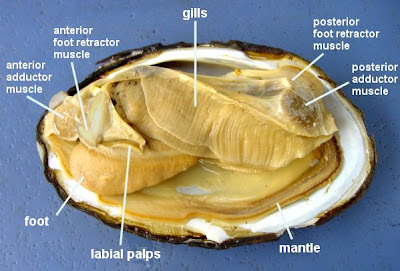Useful Reading
Campbell, Biology 6th Ed - Chapters 32 & 33, pgs 633-645, 656-671
Campbell, Biology 7th Ed - Chapters 32 & 33, pgs 626-636, 650-664
Vocabulary
Symmetry – general, structured body plan. See radial and bilateral symmetry below.
Coelom – fluid-filled body cavity surrounded by mesoderm-derived tissue.
Triploblastic – having three layers of cells during development: the endoderm, ectoderm, and mesoderm.
Protostomes – coelemate animals whose embryogenesis includes the blastopore developing into the mouth of the animal.
Segmentation – division of the body into separate, sequential cavities.
Closed circulatory system – when blood is maintained in interconnected blood vessels and not mingled with other body fluids.
Cephalization – concentration of sensory and neural organs at the anterior end of an animal.
Classification
In the previous summary, Simple Animals, we began to explore Kingdom Animalia. In this summary we look at more animal phyla, those described as protostomes. Below is a review of the current classification of animals, based on morphology and development. You should familiarize yourself with the major anatomical and developmental differences that define animal phyla.
The traditional phylogeny is shown below. It is based on the following anatomical / developmental traits:
· Presence / absence of true tissues
· Type of body symmetry
· Presence / absence of body cavity (coelom)
· Pattern of coelom development (acoelom, pseudocoelom, true coelom)
The grades of animal evolution are as follows (italics – taxa described here):
1. No true tissues (only non-specialized cells) : Parazoa
2. True tissues (functionally-specialized cells) : Eumetazoa
A. Radial symmetry, diploblastic (2 germ layers during development) : Radiata
B. Bilateral symmetry, triploblastic (3 germ layers) : Bilateria
1) No body cavities or blood vascular system : Acoelomates
2) Body cavities and blood vascular system
a. Body cavity not enclosed in mesoderm : Pseudocoelomates
b. Body cavity enclosed in mesoderm : Coelomates
i) Early development includes spiral and determinate cleavage, mouth developing from blastopore, and schizocoely : Protostomes
Annelids (earthworms)
Mollusca (snails, clams, octopi)
Arthropods (insects, spiders, shellfish)
ii) Early development includes radial and indeterminate cleavage, anus developing from blastopore, and eterocoely : Deuterostomes
(see Deuterostome lab summary)
 This phylogeny of all animals is based on morphological differences and similarities.
This phylogeny of all animals is based on morphological differences and similarities.
Protostomes
Protostomes are bilaterally symmetrical (Bilateria) and triploblastic. These terms should be familiar to you from the previous lab. Phyla within the Bilateria clade are classified according to the presence and development of a coelom (body cavity): acoelomates, pseudocoelomates, and coelomates. In the Simple Animals Lab, you learned about acoelomates and pseudocoelomates. Here, you will begin your survey of the coelomates.
Phyla within the Bilateria clade are classified according to the presence and development of a coelom (body cavity): acoelomates, pseudocoelomates, and coelomates. In the Simple Animals Lab, you learned about acoelomates and pseudocoelomates. Here, you will begin your survey of the coelomates.
Anatomy of coelomate body tissues: Body cavity is completely lined with mesoderm-derived tissue; it is a true coelom.

The two major types of coelomates are protostomes and deuterostomes. These groups differ in several characteristics of early development.

Location of Protosomes on the Morphological Phylogenetic Tree

- Phylum Mollusca (Clams, Chitons, Snails, Octopi)
Most mollusks are marine, although some live in freshwater or on land. They are soft-bodied, and most are protected by a shell. Unlike annelids, mollusks lack true segmentation. The majority of mollusks have four traits in common: 1) a hard external shell; 2) a mantle, which secretes the shell; 3) a visceral mass; and 4) a muscular foot used for locomotion. Many mollusks use a rasping organ, the radula to scrape food off the substrate. The familiar Classes of mollusks have distinctive body shapes.
- Class Polyplacophora (Chitons);

- Class Scaphopoda (the tusk shells);

- Class Gastropoda (This class is the largest molluscan class, containing the snails and slugs. Most gastropods have a single, spiraled shell, and distinct heads with eyes at the end of tentacles);


- Class Bivalvia (The bivalves include the clams, oysters and mussels. They have shells divided into two halves, which connect at a dorsal hinge. Bivalves are aquatic and have gills for suspension feeding and for gas exchange. Water flows into the mantle cavity via the incurrent siphon and leaves via the excurrent siphon. Food trapped on the gills is conducted to the mouth using cilia. Most bivalves are sedentary. They have an open circulatory system and can move using their foot);

- Class Cephalopoda (Cephalopods are markedly different from other mollusks. While still aquatic, cephalopods are mobile and can be very quick. The have much greater cephalization, with a complex brain, well-developed nervous system, large eyes, and the ability to learn complex tasks. Mobility and advanced nervous system are related to the cephalopod’s predatory nature. Cephalopods are also the only mollusks with a closed circulatory system. They have secondarily lost their shells (except in the nautilus). Their mouth is surrounded by tentacles and they bite their prey with a horny beak and inject a poison. The tentacles are used in locomotion and prey capture. A siphon is used to bring water into the mantle cavity for gas exchange via gills. The siphon is also used by squid for locomotion).

Riferimenti.

Nessun commento:
Posta un commento